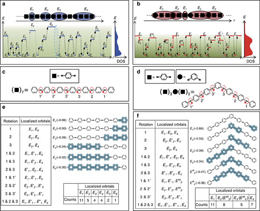Research Abstract
規則的に局在化した分子軌道を用いたπ共役ポリマーの電荷移動度を向上させる設計原理
Design principle for increasing charge mobility of π-conjugated polymers using regularly localized molecular orbitals
2013年4月9日 Nature Communications 4 : 1691 doi: 10.1038/ncomms2707

次世代電子材料としてπ共役ポリマーの利用に関する研究は幅広く行われてきたが、半導体材料において最も重要な物性指標であるキャリア輸送特性を支配する電荷移動度は、無機材料に比べて極めて低い。今回我々は、π共役ポリマー鎖を環状分子で被覆するとともに、π分子軌道をあえて規則的に局在化し、エネルギーの高さを等価にすることによって、π共役ポリマーの分子内電荷ホッピング移動を向上させる新たな設計原理を実証する。理論予測に基づき、メタ接合ポリ(フェニレン-エチニレン)を主鎖骨格として含む被覆型分子ワイヤーを設計し、合成した。このジグザグ状のワイヤーは、対応する直線状のワイヤーより高い分子内電荷移動度を示した。ジグザグ状のワイヤーの直線領域を10フェニレン-エチニレン・ユニットに増やすと、分子内電荷移動度が8.5 cm2V-1s-1に増加した。理論解析によって、この設計原理は、π共役ポリマー鎖において理想的な電荷移動度を得るのに適しており、サイト間ホッピング過程の最も有効な経路を与えることが確かめられた。
寺尾 潤1, 和田浜 彰久1, 的埜 旭隼1, 多田 朋史2*, 渡邉 聡2, 関 修平3, 藤原 哲晶1 & 辻 康之1
- 京都大学大学院 工学研究科 物質エネルギー化学専攻
- 東京大学大学院 工学系研究科 マテリアル工学専攻
- 大阪大学大学院 工学研究科 応用化学専攻
*現所属先: 東京工業大学 元素戦略研究センター
The feasibility of using π-conjugated polymers as next-generation electronic materials is extensively studied; however, their charge mobilities are lower than those of inorganic materials. Here we demonstrate a new design principle for increasing the intramolecular charge mobility of π-conjugated polymers by covering the π-conjugated chain with macrocycles and regularly localizing π-molecular orbitals to realize an ideal orbital alignment for charge hopping. Based on theoretical predictions, insulated wires containing meta-junctioned poly(phenylene–ethynylene) as the backbone units were designed and synthesized. The zigzag wires exhibited higher intramolecular charge mobility than the corresponding linear wires. When the length of the linear region of the zigzag wires was increased to 10 phenylene–ethynylene units, the intramolecular charge mobility increased to 8.5 cm2 V−1 s−1. Theoretical analysis confirmed that this design principle is suitable for obtaining ideal charge mobilities in π-conjugated polymer chains and that it provides the most effective pathways for inter-site hopping processes.

